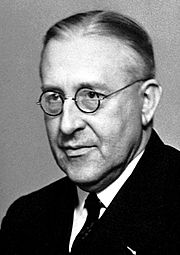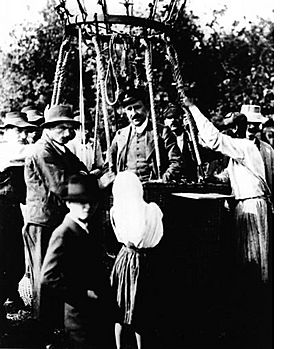Victor Francis Hess facts for kids
Quick facts for kids
Victor Franz Hess
|
|
|---|---|
 |
|
| Born |
Victor Franz Hess
24 June 1883 Schloss Waldstein, Peggau, Austria-Hungary
|
| Died | 17 December 1964 (aged 81) |
| Nationality | Austro-Hungarian, Austria, United States |
| Alma mater | University of Graz |
| Known for | Discovery of cosmic rays |
| Spouse(s) |
Marie Bertha Warner Breisky
(m. 1920–1955)Elizabeth M. Hoenke
(m. 1955–1964) |
| Awards | Nobel Prize in Physics (1936) |
| Scientific career | |
| Fields | Physics |
| Institutions | University of Graz Austrian Academy of Sciences University of Innsbruck Fordham University |
Victor Franz Hess was an important scientist from Austria and America. He was a physicist, which means he studied how the world works, like energy and matter. He won the Nobel Prize in Physics because he discovered something amazing called cosmic rays. He lived from June 24, 1883, to December 17, 1964.
Contents
Early Life and Education
Victor Franz Hess was born on June 24, 1883. His birthplace was Waldstein Castle, near Peggau in Styria, Austria. His father worked as a royal forester.
Hess went to secondary school in Graz from 1893 to 1901. After that, he studied at the University of Graz. He earned his PhD in physics there in 1910.
Early Career and Family Life
From 1910 to 1920, Hess worked in Vienna. He was an assistant at the Institute for Radium Research. In 1920, he married Marie Bertha Warner Breisky.
In 1921, Hess traveled to the United States. He worked for a radium company in New Jersey. He also advised the US Bureau of Mines.
Returning to Austria
Hess returned to the University of Graz in 1923. He became a professor of experimental physics in 1925. Later, in 1931, he moved to the University of Innsbruck. There, he became a professor and director of the Institute of Radiology.
Moving to the United States
In 1938, Hess and his wife moved to the United States. They left Austria to avoid difficulties during that time. That same year, Fordham University hired him as a physics professor. He became a citizen of the United States in 1944.
His first wife passed away in 1955. Later that year, he married Elizabeth M. Hoenke. She had cared for his first wife. Hess was a religious person and wrote about his beliefs. He retired from Fordham University in 1958. He passed away on December 17, 1964, in New York.
Discovery of Cosmic Rays
Between 1911 and 1913, Victor Hess did the work that led to his Nobel Prize. For many years, scientists were puzzled. They measured radiation in the air. They thought this radiation came from Earth. So, they expected it to decrease higher up.
However, their tools showed something different. At higher altitudes, the radiation seemed to be stronger. Hess decided to investigate this mystery. He made his measuring tools much more accurate.
Balloon Flights for Science
Hess then took his equipment high into the sky. He used a balloon for his experiments. He flew up to 5.3 kilometers (about 3.3 miles) high. He made these daring flights both day and night. It was a risky thing to do.
His careful work showed surprising results. The radiation decreased up to about 1 kilometer high. But above that, it increased a lot! At 5 kilometers, the radiation was twice as strong as at sea level.
Understanding Cosmic Rays
Hess concluded that radiation was coming from outer space. This was a huge discovery! Another scientist, Robert Andrews Millikan, confirmed it in 1925. Millikan named this radiation "cosmic rays."
Hess's discovery opened new doors in particle and nuclear physics. It helped scientists understand more about the universe. Hess shared the 1936 Nobel Prize in Physics for his groundbreaking work.
Awards and Recognition
Victor Hess received many honors for his scientific contributions. These awards recognized his important discoveries.
- Lieben Prize (1919)
- Abbe Memorial Prize
- Abbe Medal of the Carl Zeiss Institute, Jena (1932)
- Nobel Prize in Physics (1936)
- Austrian Decoration for Science and Art (1959)
- A lunar crater on the Moon is named after Hess
See also
 In Spanish: Victor Franz Hess para niños
In Spanish: Victor Franz Hess para niños


